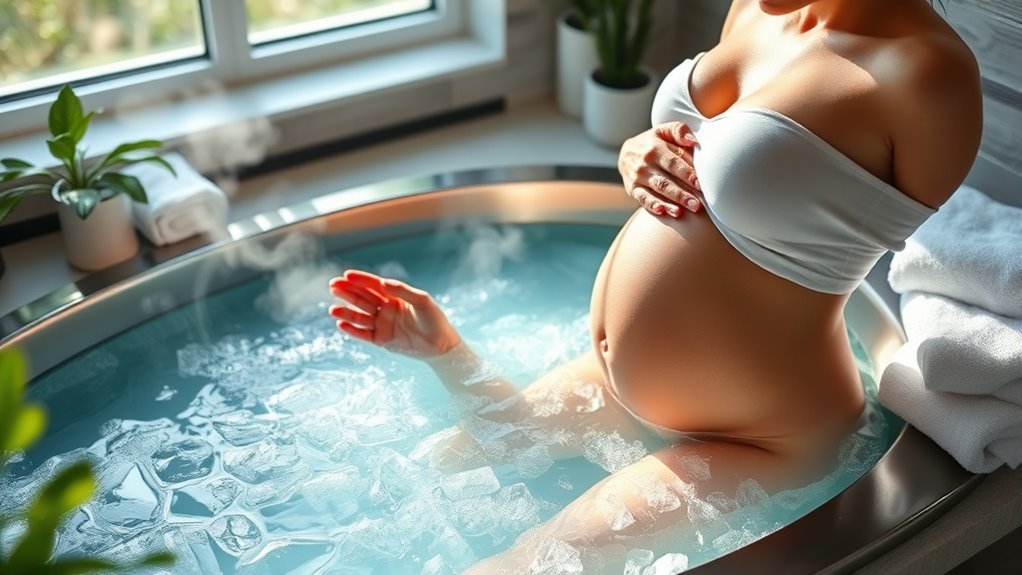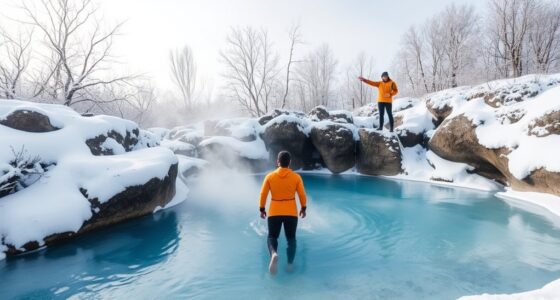Before using a cold plunge during pregnancy, consult your healthcare provider to verify it’s safe for your specific situation. Always check that the water temperature stays above 50°F (10°C) and avoid plunging in water that’s too cold. Start slowly with gradual immersion, limiting your time and listening to your body for any discomfort. Focus on bathes that don’t involve submerging your head. To learn more about safe practices, keep exploring trusted medical guidelines.
Key Takeaways
- Consult your healthcare provider before using a cold plunge during pregnancy to assess safety based on your health and pregnancy stage.
- Ensure water temperature stays above 50°F (10°C) to prevent shock and cardiovascular stress.
- Gradually immerse your body, starting with legs or hips, and avoid jumping to reduce shock risk.
- Limit sessions to a few minutes and monitor for signs of dizziness, numbness, or discomfort.
- Have a warm towel or blanket ready for post-activity warming and discontinue use if any adverse symptoms occur.

During pregnancy, many women seek ways to boost their well-being and manage discomfort, but not all wellness practices are safe. Using a cold plunge might seem appealing for its invigorating effects, but it’s imperative to approach this activity with caution. One of the most significant factors to consider is water temperature. Cold water can cause your body to react quickly, leading to a sudden drop in core temperature if the water is too cold. This could potentially affect your pregnancy, so it’s essential to ensure the water temperature remains within a safe range, generally above 50°F (10°C). Lower temperatures might induce shock, cause dizziness, or increase stress on your cardiovascular system, which isn’t advisable during pregnancy.
Before stepping into a cold plunge, you should always check and adhere to safety precautions. First, consult your healthcare provider to determine whether this practice is safe for you, based on your pregnancy stage and overall health. Every pregnancy is different, and what might be safe for one woman could be risky for another. If your provider approves, start gradually, slowly lowering your body into cooler water rather than jumping in all at once. This helps your body adapt to the temperature change and reduces the risk of dizziness or sudden discomfort.
It’s also crucial to limit your exposure time in the cold plunge. Spending too long in cold water can cause blood vessels to constrict, which might reduce blood flow to your placenta and your baby. Keep your sessions brief—generally no more than a few minutes—and monitor how you feel during and afterward. If you experience shivering, numbness, dizziness, or any unusual sensations, exit the plunge immediately and inform your healthcare provider.
Another safety precaution is to avoid submerging your head or face in the cold water, as this can cause rapid breathing or discomfort. Instead, focus on immersing your legs or hips, which minimizes shock while still providing a stimulating experience. Always have a warm towel or blanket nearby to help you gradually warm up afterward, preventing any sudden temperature changes that could be harmful.
Frequently Asked Questions
Is Cold Plunging Safe During All Pregnancy Trimesters?
Cold plunging isn’t safe during all pregnancy trimesters because cold shock can affect your thermal regulation and cause stress. In early pregnancy, your body is especially sensitive, and sudden cold exposure might increase risks. Later on, your body’s ability to handle temperature changes diminishes. Always consult your healthcare provider before attempting cold plunges during pregnancy, as they can help you determine what’s safe for your specific situation.
Can Cold Water Immersion Help With Pregnancy-Related Swelling?
Cold water immersion might help reduce pregnancy-related swelling by constricting blood vessels and decreasing fluid buildup. To do this safely, keep the water temperature moderate—around 50-60°F—and limit your immersion duration to about 10 minutes. Always listen to your body, and consult your healthcare provider before trying cold water therapy during pregnancy, especially if you experience any discomfort or complications.
Are There Any Specific Signs to Stop Cold Plunging During Pregnancy?
You should stop cold plunging if you notice symptoms like dizziness, shivering, or numbness, indicating your body’s response to temperature thresholds. Also, pay attention to signs of dehydration, such as dry mouth or dark urine. It’s essential to stay properly hydrated and avoid extreme cold exposure, as it can affect your pregnancy. Always listen to your body and consult your healthcare provider before continuing cold water immersion.
How Often Can Pregnant Women Safely Use a Cold Plunge?
You should limit cold plunge sessions during pregnancy, ideally to no more than once or twice a week. Cold exposure risks increase with frequent cold plunges, especially if water temperature is too low. Always prioritize water temperature considerations—keep it moderate and avoid extremes. Consult your healthcare provider before establishing a routine, as individual factors may influence safe frequency. Listen to your body and stop if you experience discomfort or unusual symptoms.
Does Cold Exposure Affect Fetal Development?
Think of it like the Wright brothers’ first flight—you need to be cautious. Cold exposure can affect fetal development by altering fetal temperature regulation and placental blood flow, which are essential for healthy growth. Sudden temperature drops might cause stress or reduced oxygen supply to your baby. Always consult your healthcare provider before trying cold plunges, as they can guide you on safe practices to protect your little one.
Conclusion
Remember, using a cold plunge during pregnancy is like walking a tightrope—you need to stay balanced and cautious. Always listen to your body and consult your healthcare provider before taking the plunge. While it can be invigorating, your well-being comes first, so don’t push beyond your comfort zone. When done safely, it’s a gentle reminder to care for yourself, just as a delicate flower needs careful tending to flourish.









